Within a short span of time, Odoo carved a niche of being the most trusted application among the ERP solution seekers. It has become undoubtedly the most reliant business management tool for any industry domain. The fundamental objective of the open source ERP is to make it feasible for all industries, no matter what their industry size or industry domains are. Earlier when proprietary ERP’s remained elite to high business groups, Odoo remained robust in fulfilling the needs of both SME’S and larger enterprises. Odoo always remained scalar, growing alongside the business trajectory.
The consistent upgrades alongside the flexibility to fit in any domains makes Odoo distinct from others. With each version release, the open source ERP is expanding its functional ends making it a more compulsive choice among the ERP solution seekers. With the latest release, Odoo v 12, the compulsion is all more tightened, expanding its popularity and significance.
Dating back to the history of Odoo, initially, the software took flight with a single edition i.e. the open-source (Community). However, in 2015 when Odoo v9 got released, the open source introduced the business community with their licensed edition. The edition came up with extra proprietary apps, taking the form - Odoo Enterprise. The new edition came up with additional modules for extra charges. From then on, the contrasts between the two Odoo Editions developed, giving a clear distinction in the latest release- Odoo version 12.
Cybrosys have been for a decade in Odoo ERP services and often witness the confusion and dilemma of the clients to make a choice between Odoo Community and Odoo Enterprise. This prompted us to compile a piece on the difference between Odoo Enterprise and Odoo Community. There might be already many articles online, specifying the contrast between the two. However, we haven’t seen a sufficient and satisfactory one that clearly defines the distinction.
If you are looking for such a reference, continue reading this article.
To brief, Odoo Community and Enterprise differ in four aspects:
1. Modules/Features
2. Support, Bug fixes, and Upgrades
3. Hosting Options
4. Pricing
Modules & Features
Functionality can be described as the most notable difference between the two Odoo editions. Odoo Enterprise comes as the platinum version of Odoo, built on the base of Odoo community. It has numerous extra modules and highlights in the plate to offer the end user.
Odoo Enterprise = Odoo Community Basic Modules+ Additional Features.
If we take up the latest release- Odoo v12, one can find that enormous scale upgrades are solely found on the licensed edition. The multi-website management and IP-address lead generation feature is a stand-still proof for this. Also the modules such as Document Management, Studio and IoT are only made available in the Enterprise Edition of Odoo, dismaying the Odoo community users.
Coming to feature contrast, the gap between community and enterprise is quite wide. To list a few, the E-commerce module in Odoo Enterprise version 12 comes with advantages such as pre-built shipping integrations, connector to eBay. Meanwhile, the manufacturing module under the Enterprise edition offers the benefits of Quality Control, Maintenance, Product Lifecycle Management, and IoT Integration. With Odoo V12, working with work center has also been improvised to a great extent. Availing the Enterprise benefits, the business organization can now seamlessly schedule, control and plan their production activities. Last but not least, a full accounting is only made available to the Enterprise Users.
Full Accounting comes with generic and dynamic reports of the following. These reports can be highly beneficial for your accountants as this helps them in precisely tracking the current financial position and status of the organization.
1. Balance Sheet
2. Profit and Loss
3. Chart of Account
4. Executive Summary
5. General Ledger
6. Aged Payable
7. Aged Receivable
8. Cash Flow Statement
9. Tax Report
10. Bank Reconciliation
Balance Sheet giving insight on assets, liabilities, and equity of your business organization on a particular date.
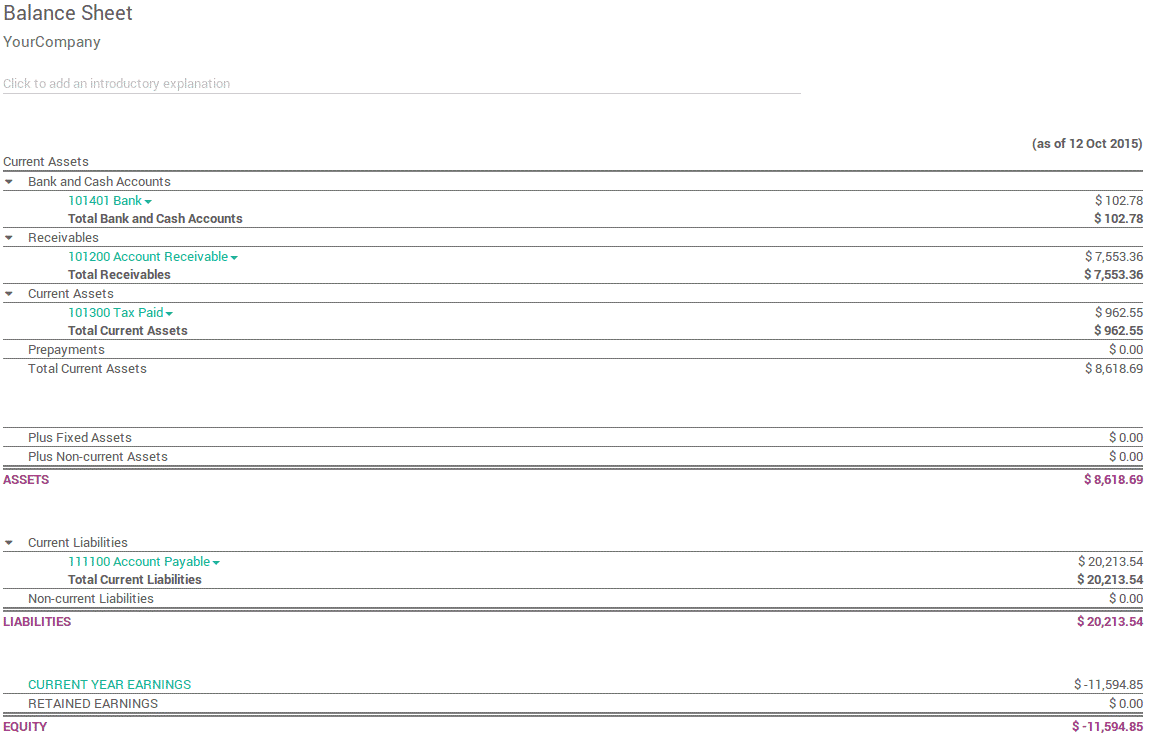
Profit and Loss report displaying the organization’s net income, via deducting expenses from revenue for the report period.
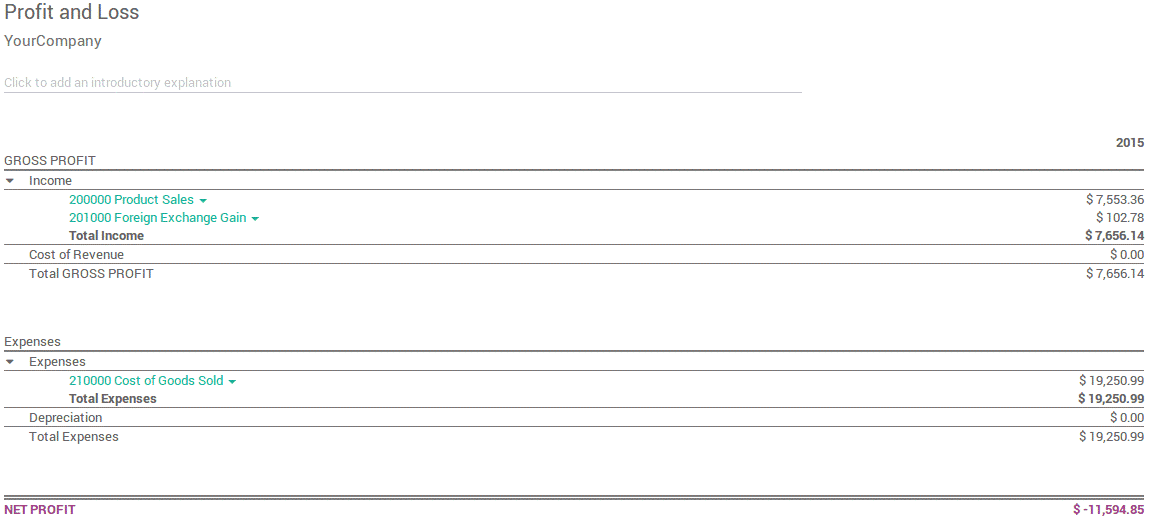
Chart of account- listing every account grouped by class.

Executive Summary on gross profit margin, net profit margin, return on investment, the ratio of current assets to current liabilities and so forth.
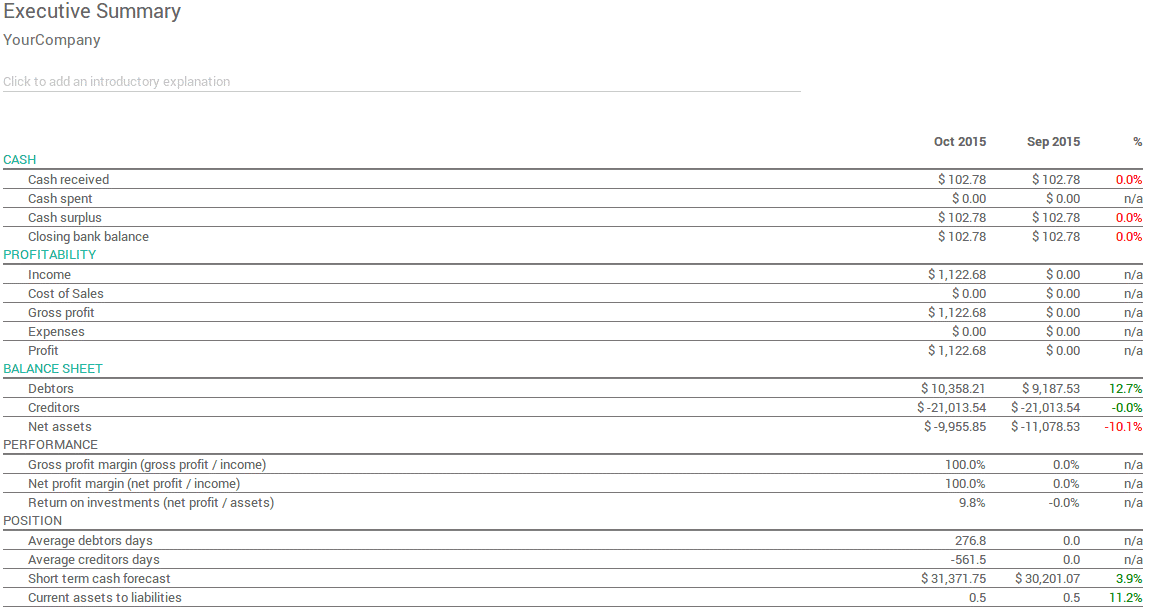
General Ledger displaying every transaction from every accounts for a chosen date range. This report can be highly significant for the business as it helps in checking every transaction that occurs at a certain point of time.
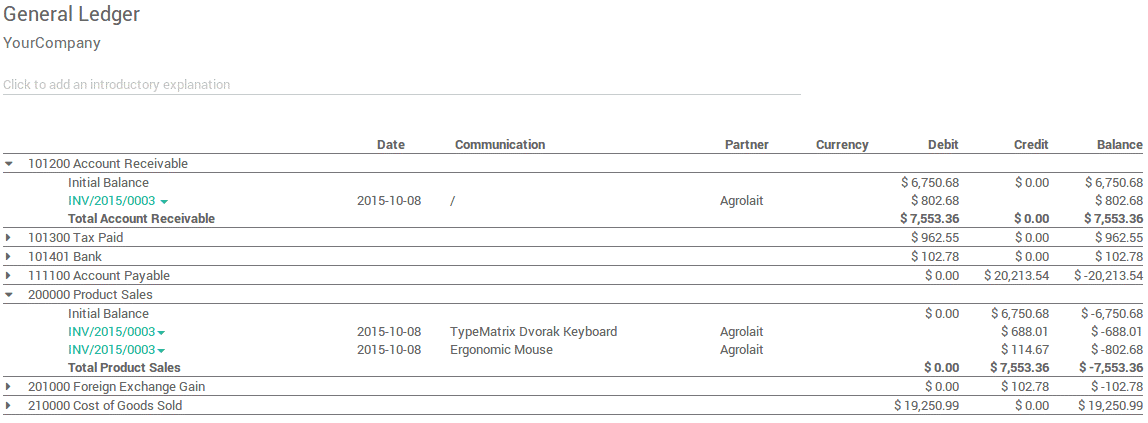
Aged Payable
Displays data on individual bills, credit notes, and overpayments owed by the company. It also defines how long it’s been unpaid.

Aged Receivable
The report displays the sales invoices that were awaiting payment during the chosen month and a while earlier.

Cash Flow Statement
The Cash Flow Statement demonstrates how changes in balance sheet records and pay influence cash and cash equivalents.
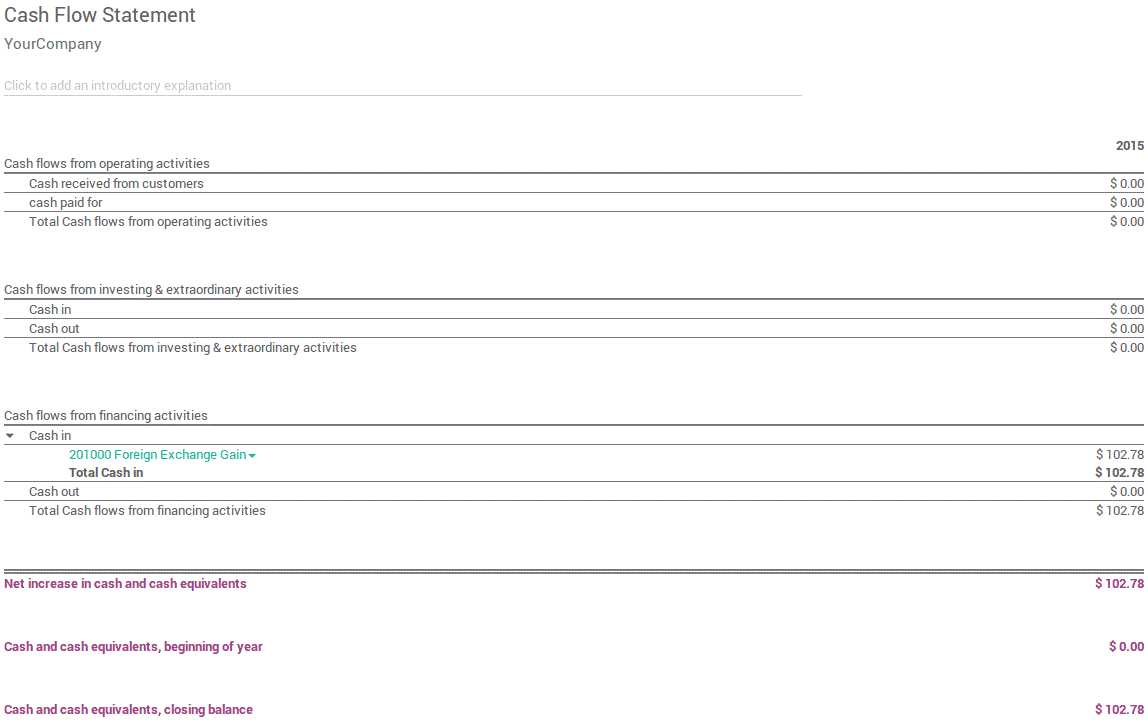
Tax Report
Displays net and tax amounts for every taxes grouped by type (sale/purchase).

Bank Reconciliation
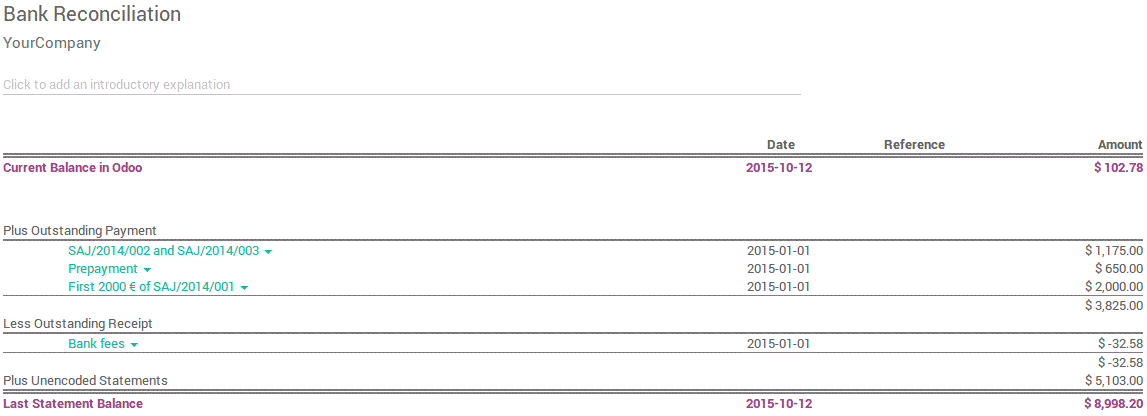
You can read the complete list of features from the below table. However, continue reading to figure out the contrast over hosting, support, and pricing of two Odoo Editions.
Studio
|
Enterprise
|
Community |
| ScreenCustomization |
|
|
| ReportDesigner |
|
|
| MenusEditor |
|
|
| AppsCreator |
|
|
Accounting
|
Enterprise
|
Community |
| Invoicing and Payments |
|
|
| full accounting |
|
|
Project Management
|
Enterprise
|
Community |
| Tasks |
|
|
| Timesheets |
|
|
| Forecasts |
|
|
Sales Management
|
Enterprise
|
Community |
| CRM |
|
|
| Sales |
|
|
| CustomerPortal |
|
|
| eSignature |
|
|
| Subscriptions |
|
|
| digital products |
|
|
| Helpdesk |
|
|
| VoIP integration |
|
|
Human Resources
|
Enterprise
|
Community |
| EmployeeDictionary |
|
|
| Expenses |
|
|
| Leaves |
|
|
| Recruitments |
|
|
| Appraisals |
|
|
| DepartmentsDashboard |
|
|
Inventory
|
Enterprise
|
Community |
| Inventory management |
|
|
| Purchase management |
|
|
| Barcode Support |
|
|
| Shipping: UPS, Fedex, DHL, USPS |
|
|
| Multi-company flow |
|
|
Manufacturing
|
Enterprise
|
Community |
| MRP |
|
|
| IoT |
|
|
MRP II (Work Center Control Panel and Scheduling)
|
|
|
| PLM |
|
|
| Maintenance |
|
|
| Quality |
|
|
| Shipping: UPS, Fedex, DHL, USPS |
|
|
Website Builder
|
Enterprise
|
Community |
| WebsiteBuilder |
|
|
| Blogs |
|
|
| Presentations |
|
|
| Themes |
ExtraFee |
ExtraFee |
| FormBuilder |
|
|
| Call-to-action Blocks |
|
|
| Versioning |
|
|
| A/B testing |
|
|
E-commerce
|
Enterprise
|
Community |
| Full eCommerce |
|
|
| Shipping Connectors |
|
|
| eBay Connector |
|
|
Point of Sale
|
Enterprise
|
Community |
| Point of Sale |
|
|
| POS Restaurants |
|
|
| Loyalty Cards |
|
|
Marketing
|
Enterprise
|
Community |
| Events |
|
|
| Expenses |
|
|
| Email Marketing |
|
|
| Live Chat |
|
|
| Marketing Automation |
|
|
Miscellaneous
|
Enterprise
|
Community |
| Chat |
|
|
| Google spreadsheet Integration |
|
|
| Fleet |
|
|
| Notes |
|
|
| Appointments |
|
|
To know in detail, the complete specifications available in Odoo 12 Enterprise and Odoo Community, also refer our blog odoo12 community vs enterprise
Support, Bugfixes, and Upgrades
The second significant contrast is support. Numerous organizations rely on further support rather than the endless feature list. The unlimited functional support from Odoo can be only availed by the Enterprise users. Meanwhile, the community users have to rely on their service provider to get things done.
Also, Odoo offers their upgrade assistance as long as it is into an Enterprise adaptation, for example from Community to Enterprise or Enterprise to Enterprise.
General
|
Enterprise
|
Community |
| Unlimited Functional Support |
|
|
| Version Upgrades |
|
|
| Hosting |
|
|
Hosting Options
Hosting- this is the third and yet another notabledifference between the two.
With Odoo Community, you handlehosting yourself, no matter utilizing your very own on-premise servers orfacilitated servers. Given this is your very own open-source instance; thereforethe user gets full flexibility to customize it the way they want.
However, with Enterprise, thebenefits are much more. Apart from the on-premise hosting and cloud hosting, theuser also gets the benefits of additional cloud hoisting choice through Odoo.shand Odoo SaaS. However, it cannot be customized as it works in a multi-inhabitant model where everybody gets access to the same software.
Odoo EnterpriseHosting
|
Odoo CommunityHosting
|
On-premise hosting
|
On-premise hosting
|
Cloud hosting (AWS, Digital Ocean, Google Cloud, etc.)
|
Cloud hosting (AWS, Digital Ocean, Google Cloud, etc.)
|
Cloud hosting (Odoo.sh)
|
-- |
SaaS (non-customizable)
|
-- |
Pricing
To many, Odoo Community edition seems more affordable comparing to Odoo Enterprise. And this thought comes in light of the yearly expenses of Odoo Enterprise license fees.
However, this doesn’t shade Odoo Community as the affordable choice because which choice is better in terms of pricing solely depends on what you’re searching for from your Odoo instance.
Let’s see how.
Odoo Enterprise comes with numerous out-of-box modules/features that the Odoo Community lacks within. Now in case, if your business organization wants to set up the very same features in their Odoo Community instance, the organization is moreover to witness a bump in price.
You may seem the license raising the Enterprise costs; however, you should also understand that the customization and development likewise raise the expense of Community. The cost of owning the Odoo Community can rise with increasing specifications of your business. If the specifications are large, the cost amounting to customization and development eventually takes a toll. Therefore, the choice among the Odoo Community and Odoo Enterprise should be solely made upon the features you look for and the degree of customization/development you’re searching for.
If the customer is in need of a substantial amount of customization in his community instance, the total cost of ownership is to rise high. However, choosing Odoo Enterprise Edition in that place can save the customer from spending a huge expenditure, making it fundamentally more affordable.
Despite the fact that Enterprise had yearly permit costs, Community had greater expenses for the initial development. Additional developments each year alongside migration cost will further burden the community users contrasting the Enterprise.
User Interface
The most preferred standpoint of Odoo Enterprise over Odoo Community is that it comes optimized for all gadgets like desktop, tablet, smartphone, and so forth. This implies that the content automatically gets adjusted to the gadget, offering great flexibility in reading, write and act.
User interface
|
Enterprise
|
Community |
| Desktop |
|
|
| MobileApplication |
|
|
Moreover, Odoo Enterprise looks a lot tidier and increasingly proficient. For instance: the space of inner notes, message sending, and activity schedule will be displayed in the desktop version on the right side of the content and will be moved beneath the content if the gadget width changes. Under Odoo Enterprise everything looks exceptionally brilliant, professional and mature.
Odoo is an amazing ERP solution with two incredible editions to browse. Eventually, the decision among Community and Enterprise truly comes down to what you're searching for from your Odoo instance.
Odoo Enterprise offers great backing from Odoo, more set of features and hosting option. However, has its license fees. In case, if these features aren’t right now significant for you, or your IT group, Odoo Community might be the better choice.
Cybrosys is an Odoo Official Partner and can serve you in both Odoo Community and Odoo Enterprise Edition. To avail our service, drop your business request to odoo@cybrosys.com